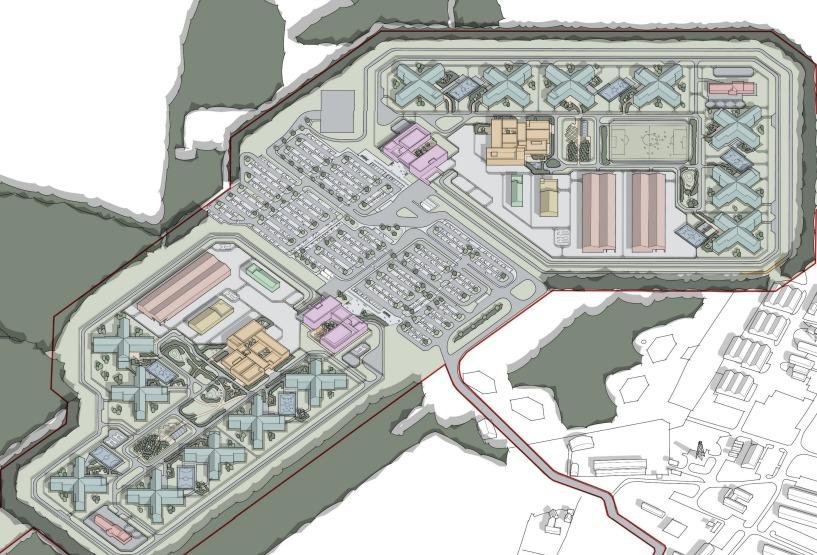
Environmental Impacts
Why Build Prisons in Wethersfield?
The UK Ministry of Justice (MoJ) is proposing to develop two huge mega-prisons housing over 3,000 prisoners and over 1,500 staff on the site of the old Wethersfield airfield – in the midst of our remote and beautiful countryside. The site has been chosen not because it is suitable but simply because it is available, as the Ministry of Defence (MoD) own the land.
The proposal takes no account of the area’s distance from courts, lack of local employment opportunities to rehabilitate prisoners, unsuitable B roads, infrequent public transport and shortage of potential prison service recruits. It will lead to thousands of construction vehicles, HGVs and car traffic for staff, deliveries and visitors squeezing down narrow B roads past dozens of listed buildings and several primary schools. This would be the largest prison complex ever built in this country with over 1,000 car park spaces, 20 metre high buildings, require 24-hour bright security lighting and be an ugly blot on the landscape. The prisons’ air, noise, water and light pollution will have a major effect on the local natural and built environment and the health and well-being of residents in several nearby local villages, including Shalford, Great Bardfield, Toppesfield and Finchingfield, one of the most attractive in the country.
The MoJ’s very brief ‘consultation’ in September, 2021 included only a fraction of the number of people who will be affected and did not provide sufficient accurate information. The proposal flies in the face of the Government’s commitment to sustainable development reiterated at the Glasgow COP summit in November, 2021. This commitment includes recent proposals to change how we manage the countryside; provisions to protect local communities and habitats under the National Planning Policy Framework (NPPF) and local empowerment legislation; and the entire ethos of the ‘Build Back Better’ and ‘Levelling up’ agenda in a post-Brexit and post-Covid Britain.
We need to take a holistic approach to sustainable development, which includes what is best for local people, prisoners and staff, as well as the local environment. The challenge we face is what type of world do we want our children to grow up in? In helping us address it, the following are some points we may want to think about.
-
HOME - UN Climate Change Conference (COP26) at the SEC – Glasgow 2021 (ukcop26.org)
The Sustainable Development Agenda - United Nations Sustainable Development
About Doughnut Economics | DEAL
Farmers could be paid for post-Brexit 'rewilding' land changes - BBC News
Localism Act 2011 (legislation.gov.uk)
LGA, 2021 The Levelling Up agenda, House of Commons, 15 June 2021
The Natural Environment
During their construction and operating phases, large scale building developments have a direct impact on our daily lives, health and well-being through the air that we breathe and a long-term impact on our children through their effect on greenhouse gas (GHG) emissions. The construction industry is a major source of pollution, responsible for around 4% of particulate emissions, more water pollution incidents than any other industry and thousands of noise complaints every year.
Air Pollution
Construction pollutes the air through land clearance, operation of diesel engines, demolition, burning, and working with toxic materials. High levels of microscopic dust containing traces and particles of concrete, cement, wood, stone, sulphates and silica can be spread over several miles. Construction sites can also release carbon monoxide, carbon dioxide, nitrous oxide, hydrocarbons and noxious vapours from oils, glues, thinners, paints, treated woods, plastics, cleaners and other hazardous chemicals into the atmosphere. Although these emissions are invisible to the naked eye, their effects can be insidious. They can penetrate deeply into the lungs and cause a wide range of health problems, including respiratory illness, asthma, bronchitis and even cancer.
Although some reductions are possible, the fact remains the cement sector still accounts for 7 percent of global GHG emissions. If the global cement sector was a country, it would be the 3rd largest emitter in the world.
“Close to a quarter of energy-related global greenhouse gas (GHG) emissions are generated by the transport sector”.
Light and Noise Pollution
Bortle Scale
The bortle scale is a way to measure the brightness of the night sky.
Light pollution: One thing we all notice when we find ourselves outside a large city, is the darkness of the night sky. Apart from being able to see the stars better on a clear night, why does that matter? Well, the simple answer is that wildlife looks at the sky too but is far more likely to be adversely affected by changes in light levels. Even during the day, some building materials can be mistaken for water. How do we put an ‘offset value’ on that?
Noise Pollution: The noise from a construction site and road traffic are fairly obvious but we often ignore the impact it has on our lives and well-being. Not only is noise annoying and distracting but it can cause a range of cause health problems including hearing loss, high blood pressure, sleep disturbance and stress and not only for humans. Research suggests that high noise levels disturb the natural cycles of animals and forces them to migrate to new habitats.
Water Pollution
Water pollution: Sources of water pollution on building sites include: diesel and oil; paint, solvents, cleaners and other harmful chemicals; and construction debris and dirt. When land is cleared and construction begins, it causes soil erosion and run-off of water containing silt, diesel, oil, toxic chemicals, and building materials like cement. Once these pollutants enter natural waterways, they destroy aquatic life and harm any wild or farm animal that drinks from them. Pollutants on construction sites can also soak into the groundwater, a source of human drinking water. Once contaminated, groundwater is much more difficult to treat than surface water.





